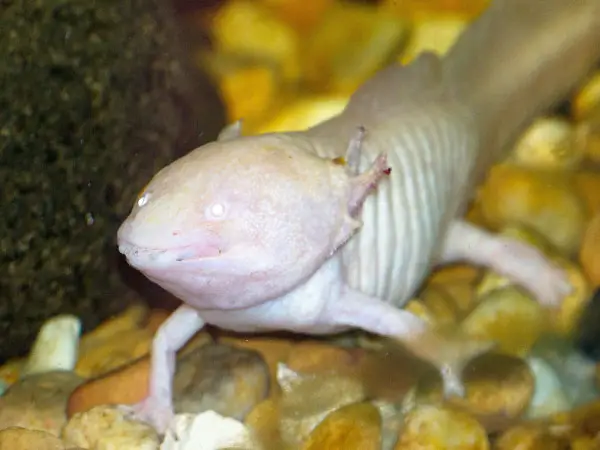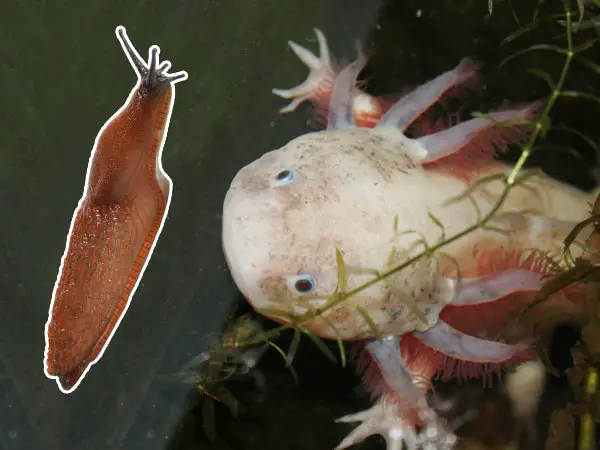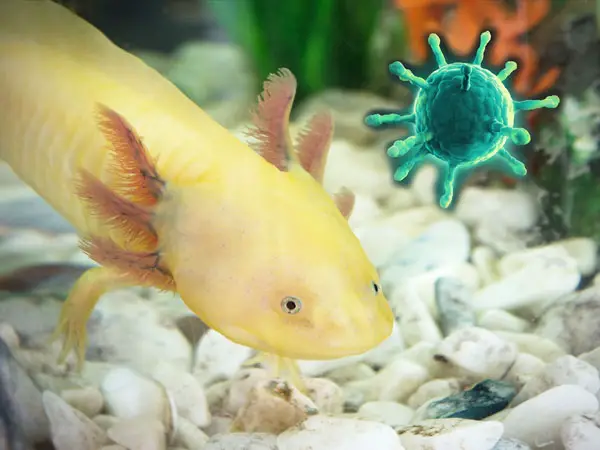One of the most worrying things when owning an axolotl, or any animal, for that matter, is seeing them fall sick. Each animal has its type of illnesses, and these have their own signs. With axolotls, we can tell quite quickly whether something is wrong, although some sicknesses have similar symptoms to other problems that can be solved easily.

Knowing the symptoms of diseases is, therefore, crucial. What happens when my axolotl is sick? What are the symptoms that I should look for? Is it just a small problem, or does the disease require the help of a vet?
Sometimes, other problems might show similar symptoms to diseases. For example, if the water temperatures are wrong, or in case of ammonia poisoning, we might notice similar problems to some of the diseases that can also be deadly.
That’s why it’s important to act fast. And the first step is recognizing the symptoms and then taking appropriate action. It might be wise to measure water parameters and temperatures; if there’s no problem with that, it might be something more serious.
In this article, we’ll take a look at the most common symptoms of diseases in axolotls, and how to act when we notice them.
Signs of Axolotls Sickness
Here are some of the most common symptoms of diseases that axolotl owners have to deal with. We’ll go over them, and see whether they are solvable, and if there is reason to be concerned.
Axolotl is Refusing to Eat
This is one of the most common symptoms we see with axolotls, and it’s a tricky one because we don’t know for sure what the matter is. It can be due to several problems, and some are more serious while others can be solved.
Perhaps you see your axolotl not eating, or eating much less than they usually do. In addition, you might notice them vomiting or throwing food back from their mouths. Here are some of the more common reasons for this:
- Can be caused by gas buildup, constipation, or even impaction.
- Perhaps you’re overfeeding your axolotl and that’s why it’s not eating. Try to remember what you fed your axolotl, and how much.
- Excess stress can also cause them to refuse food.
- Wrong water parameters, high toxicity levels, and temperature can cause them to not eat.
So now we know why they might not eat, but how to solve the problem?
If it’s constipation, wait for a few days and don’t feed them much. If it’s impaction, you can consider fridging the axolotl until the impaction clears. Monitor the axolotl regularly.
In the case of overfeeding, refrain from feeding the animal for a few days, and monitor the happening.
Stress can be due to many reasons: other animals, wrong water parameters, dirty water, and more. The last point and stress are connected, so check the water parameters and make adjustments that are necessary.
Gills Falling Off
If we see gills falling off or in really bad condition, it is likely due to poor water conditions. It might also be due to bacterial or fungal infection, which can be particularly hard to get rid of.
In addition to this, you might see skin problems, and rashes or other formations all over the body. It can be due to an infection, or it can be due to stress; and stress in this case is caused by water flow that is too strong.
So how to solve the problem?
- If it’s an infection, you can try to give your axolotl a salt bath and hope for the best. It will take several salt baths to see the infection go away gradually. It’s a stubborn thing, especially if it’s a fungal infection.
- If it’s due to stress, make water measurements right away. If the parameters are off, cycle the water until the parameters are at an optimal level. Then, of course, keep them at those levels in the future.
- Inspect the water flow coming from the filter. If you think it’s too strong, try reducing it.
Slime Coat is Shedding
If your axolotl has flaky skin or if it’s shedding the skin (slime coat), then most likely it’s caused by wrong water parameters and high toxicity levels. It can also be due to stress, but the first reason is more likely.
If you see this behavior, there’s a couple things you can try:
- Try a salt bath.
- Regulate the water parameters.
- Decrease the stress factors.
Floating at the Surface
If you notice the axolotl floating at the surface, then that’s a reason for concern. In rare cases, the axolotl might be floating at the surface due to the bubbles they create. Most likely, it’s due to impaction.
Other symptoms of this are frantic swimming, and being unable to swim to the bottom. In the case of impaction, you’ll have to perform a fridging treatment for the axolotl if the floating persists.
Swimming Upside Down
Seeing your axolotl swim upside down is a serious problem. In this case, it might be a very serious issue that if severe, cannot be solved.
Although it can be due to several reasons:
- High toxicity levels.
- Serious infection.
- Severe overfeeding.
Whatever the case might be, it might be a good idea to try and relocate the axolotl into a spare tank where the water is dechlorinated and with the right parameters. You can also try the fridging treatment if you think it’s impaction. Hopefully, your axolotl will recover.
Throwing Up Food
When the axolotl throws up food, it’s likely nothing serious. They might just not like the food you feed them, or because you’re overfeeding them.
Also, it can be due to high ammonia levels. First, check the water parameters. If you notice the wrong ammonia levels, make regular water cycles.
In the case of overfeeding or wrong foods, consider their diet. Don’t feed them for a couple of days, and keep the food varied in the future. Buy only high-quality foods, and combine with live, frozen foods, and flakes.
Conclusion
So there you have it, these are the most common symptoms of diseases with axolotls and how you can treat them. Hopefully, your axolotl will recover with the tips we have provided here.





What was wrong with the axelotl from the first picture of this page? Mine looks like him and the treatments from the vet are not working.
It ded..